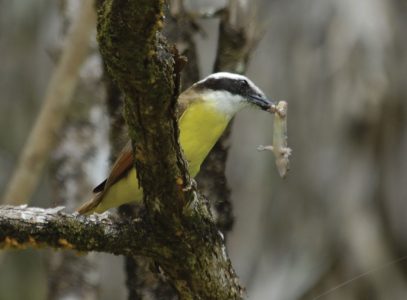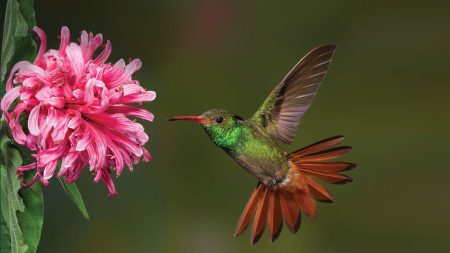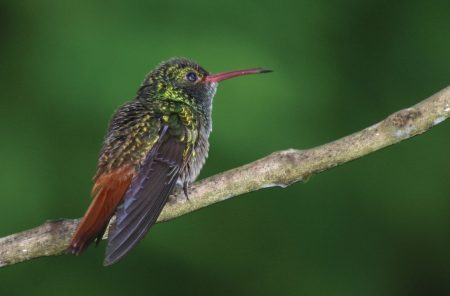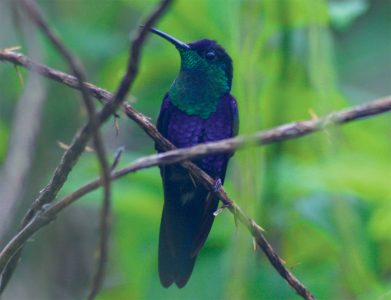Fancy Fliers
Birds That Defy Gravity in More Ways Than One
In past writings, I have referred to the Swifts and Swallows as the jet planes of the bird world. They are fast, but not very maneuverable and feed by swooping down with their mouths wide open at high speed through swarms of mosquitos, gnats, and other small insects. Being fast has its downside. Most of them can’t take off from a flat surface, and if they unintentionally happen to find themselves on the ground, they’re stuck there. Many are known to sleep while clinging to high twigs that allow them a downward launch for their take-off. Others cling to a vertical surface such as a wall, a cliff, or even inside of a chimney. Some species of swifts are even believed to sleep while cruising at high altitudes. In rural southern Costa Rica, there is a saying that the rainy season isn’t here to stay until the swifts and swallows arrive. The beginning of the rainy season coincides with the arrival of swarms of small, flying insects as well, and these, of course, are what bring the swifts and swallows.
 The flycatchers are the stunt planes of the bird world. I once watched a Social Flycatcher fly straight out from its perch, stop in mid-air, grab an insect with its beak, and return to the same perch without dropping an inch. I think most of the 384 species of flycatcher, all of which are found in the New World, are capable of doing the same. Of course, they don’t always fly straight out. A flycatcher goes to where it sees an insect, up, down, or to the side. A Guide To The Birds Of Costa Rica by Stiles and Skutch lists 79 species in Costa Rica, and we have identified 24 species on Hacienda Barú. Without them, our insect population would be many times greater than it already is.
The flycatchers are the stunt planes of the bird world. I once watched a Social Flycatcher fly straight out from its perch, stop in mid-air, grab an insect with its beak, and return to the same perch without dropping an inch. I think most of the 384 species of flycatcher, all of which are found in the New World, are capable of doing the same. Of course, they don’t always fly straight out. A flycatcher goes to where it sees an insect, up, down, or to the side. A Guide To The Birds Of Costa Rica by Stiles and Skutch lists 79 species in Costa Rica, and we have identified 24 species on Hacienda Barú. Without them, our insect population would be many times greater than it already is.
Did you know that all 330 known species of hummingbirds live in the New World? Of these, 51 species are found in Costa Rica, and 18 have been identified at Hacienda Barú.
 One morning I was on our porch watching birds when some tiny dark objects, flitting around, above the treetops caught my eye. Zipping up and down and back and forth, it occurred to me that whatever they were, they were eating insects. Reaching for my binoculars and quickly bringing them to my eyes, I determined that I was watching hummingbirds. I knew that insects formed part of their diet, but after a little searching on the internet, I found out just how important they are in fulfilling the nutritional needs of a hummingbird. Caterpillars, larvae, spiders, and insects of all kinds provide protein, fat, vitamins, minerals, other nutrients, and a significant amount of water for the tiny birds. Additionally, the abrasiveness of the insect’s exoskeleton naturally cleans and sharpens the beak while the hummingbird catches and chews the insects. We all know that these colorful little birds consume nectar, but in reality, it is more of a quick fix when they need energy fast. It’s like when you’re engaged in a strenuous sport and grab a high-energy drink for a quick uplift. A hummingbird eats around eight times its body weight daily and needs lots of energy.
One morning I was on our porch watching birds when some tiny dark objects, flitting around, above the treetops caught my eye. Zipping up and down and back and forth, it occurred to me that whatever they were, they were eating insects. Reaching for my binoculars and quickly bringing them to my eyes, I determined that I was watching hummingbirds. I knew that insects formed part of their diet, but after a little searching on the internet, I found out just how important they are in fulfilling the nutritional needs of a hummingbird. Caterpillars, larvae, spiders, and insects of all kinds provide protein, fat, vitamins, minerals, other nutrients, and a significant amount of water for the tiny birds. Additionally, the abrasiveness of the insect’s exoskeleton naturally cleans and sharpens the beak while the hummingbird catches and chews the insects. We all know that these colorful little birds consume nectar, but in reality, it is more of a quick fix when they need energy fast. It’s like when you’re engaged in a strenuous sport and grab a high-energy drink for a quick uplift. A hummingbird eats around eight times its body weight daily and needs lots of energy.
 Not only do they need energy to catch food but also to escape becoming food for a plethora of predators. Domestic cats are number one on the list followed by birds of prey and many others. I was once watching a Rufous-tailed hummingbird approach a bright orange flower. Sitting on a stump with its head beside to the flower was a Spiny-tailed Iguana. Into the flower went the beak of the hummingbird and fast as lightning the iguana grabbed the bird, gulped three times, and swallowed it. Surprisingly Praying mantises are known to kill and eat hummingbirds. Spiderwebs can entangle a hummingbird and render it helpless where it will soon starve or become food for some other bird or animal.
Not only do they need energy to catch food but also to escape becoming food for a plethora of predators. Domestic cats are number one on the list followed by birds of prey and many others. I was once watching a Rufous-tailed hummingbird approach a bright orange flower. Sitting on a stump with its head beside to the flower was a Spiny-tailed Iguana. Into the flower went the beak of the hummingbird and fast as lightning the iguana grabbed the bird, gulped three times, and swallowed it. Surprisingly Praying mantises are known to kill and eat hummingbirds. Spiderwebs can entangle a hummingbird and render it helpless where it will soon starve or become food for some other bird or animal.
If the swifts and swallows are the jet planes of the bird world, and flycatchers are the stunt planes, I would have to classify the hummingbirds as the helicopters. The unique anatomy of their shoulder joints permits full rotation of the wings, which combined with rapid wingbeats allows them to fly up, down, back, and forth, and even to hover. Beautiful, interesting, and versatile, hummingbirds are some of the most fascinating creatures found in Costa Rica.
 Jack Ewing was born and educated in Colorado. In 1970 he and his wife Diane moved to the jungles of Costa Rica where they raised two children, Natalie and Chris. A newfound fascination with the rainforest was responsible for his transformation from cattle rancher into environmentalist and naturalist. His many years of living in the rainforest have rendered a multitude of personal experiences, many of which are recounted in his published collection of essays, Monkeys are Made of Chocolate. His latest book is, Where Jaguars & Tapirs Once Roamed: Ever-evolving Costa Rica.
Jack Ewing was born and educated in Colorado. In 1970 he and his wife Diane moved to the jungles of Costa Rica where they raised two children, Natalie and Chris. A newfound fascination with the rainforest was responsible for his transformation from cattle rancher into environmentalist and naturalist. His many years of living in the rainforest have rendered a multitude of personal experiences, many of which are recounted in his published collection of essays, Monkeys are Made of Chocolate. His latest book is, Where Jaguars & Tapirs Once Roamed: Ever-evolving Costa Rica.

